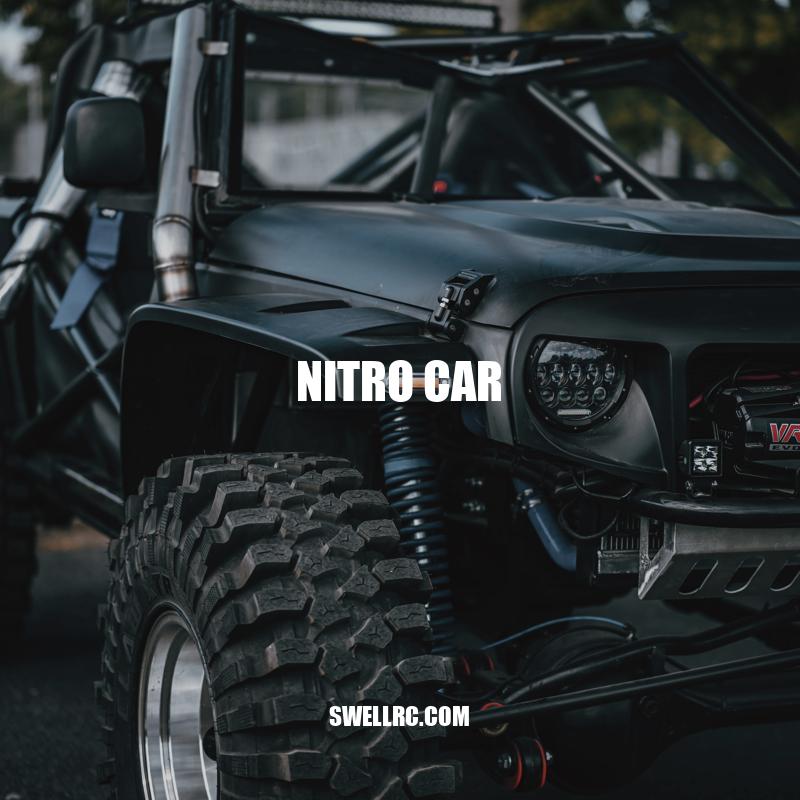Exploring the World of Nitro Cars: Components, Pros and Cons, Maintenance, Racing, and How to Choose the Right One
Nitro cars are a thrilling hobby for remote control car enthusiasts and adrenaline junkies alike. These miniature vehicles are powered by a nitro-powered combustion engine, which provides an exhilarating and fast-paced driving experience. Nitro cars come in a variety of sizes and styles, from small 1/18th scale models to larger 1/8th scale models that can reach speeds of up to 70 miles per hour. But what exactly makes these miniature cars so special? In this article, we’ll provide an overview of nitro cars, explaining how they work, their pros and cons, and what to consider when choosing the right model. Whether you’re a seasoned remote control car enthusiast or a newcomer to the world of nitro cars, this guide will provide valuable insights into this exciting hobby.
Nitro Car Components
A nitro car is made up of several key components, each of which plays a critical role in the overall functionality of the vehicle. Understanding these components is crucial if you’re looking to get the most out of your nitro car. Here are the essential parts of a nitro car:
- Nitro engine: This is the power source for the car. It uses a mixture of nitro fuel and air to create internal combustion, which drives the car’s wheels.
- Fuel tank: This component stores the nitro fuel for the engine. It typically has a capacity of around 75ml for 1/10th scale nitro cars.
- Exhaust system: This is the mechanism that removes the waste gases produced by the nitro engine as part of the combustion process.
- Transmission: The transmission is responsible for transferring power from the engine to the wheels. In most nitro cars, this is a single-speed transmission.
- Chassis: The chassis is the framework upon which all the other components are mounted. It provides the necessary support and protection for the car.
- Suspension: This system is responsible for absorbing shocks and maintaining the stability and control of the vehicle.
- Tires: The tires are the only contact point between the car and the road surface. They come in different sizes, treads, and compounds to suit different driving conditions.
If you’re interested in purchasing a nitro car or upgrading an existing one, there are many online stores that specialize in these vehicles. Some popular options include NitroRCX, HobbyKing, and Tower Hobbies. You can also find plenty of online forums and communities dedicated to nitro cars, where you can connect with other enthusiasts and get advice on everything from maintenance and repairs to customizing and tuning your car for improved performance.
What do you need for a nitro RC car?
To start using a nitro RC car, you will need the following:
| Item | Description |
|---|---|
| Nitro fuel | Special fuel specifically made for nitro RC cars. You can find it at your local hobby store or order it online. |
| Glow plug igniter | Ignites the fuel in the engine. You can purchase one at your local hobby store or online. |
| Nitro engine starter kit | Basic kit that contains a fuel bottle, glow plug wrench, and other essential tools you might need. Available for purchase online or at your local hobby store. |
| Batteries | You will need rechargeable batteries to power the car’s control system. Check the car manual for the specific battery requirements. |
| RC car kit or pre-built car | You can either purchase an RC car kit that you can assemble yourself or opt for a pre-built car that is ready to run. |
If you need more information on nitro RC cars, check out websites like HorizonHobby.com or Amainhobbies.com for a variety of products and helpful resources.
Pros and Cons of Nitro Cars
Like any vehicle, nitro cars come with their own sets of advantages and disadvantages. Understanding these can help you decide if a nitro car is right for you. Here are some pros and cons to consider:
Pros:
- Increased speed and performance: Nitro engines offer more power and speed compared to electric motors, making nitro cars a popular choice for racing enthusiasts.
- Realistic engine sounds: Nitro cars produce the same throaty roar as their full-sized counterparts. This adds to the overall sensory experience of driving a nitro car.
- Highly customizable: Nitro cars can be easily modified and upgraded to improve performance, handling, and aesthetics. From engine tuning to customized paint jobs, the possibilities are endless.
- Long run times: Nitro cars have longer run times compared to their electric counterparts, which need to be recharged more frequently.
Cons:
- Regular maintenance required: Nitro cars require regular maintenance to keep the engine running optimally, including cleaning the engine, tuning the carburetor, and replacing worn-out parts.
- Expensive: Nitro cars are generally more expensive than electric cars, due to the cost of the nitro fuel, the complexity of the engine, and the need for specialized parts and tools.
- Noisy: While the roar of the nitro engine can be exciting, it can also be loud and disruptive, making it less suitable for quiet suburban areas.
- Emissions: Nitro engines produce emissions in the form of nitrous oxide, which contributes to air pollution and can be harmful to the environment.
If you’re still unsure whether a nitro car is right for you, consider renting or borrowing one to try it out before making a purchase. And remember, safety should always be a top priority when operating a nitro vehicle. Always wear appropriate safety gear and follow the manufacturer’s instructions and safety guidelines.
What’s the difference between petrol and nitro RC cars?
Petrol and nitro RC cars are both popular types of remote control vehicles. There are a few key differences between the two:
| Petrol RC cars | Nitro RC cars |
| — | — |
| Use a mixture of petrol and oil as fuel | Use a mixture of nitromethane, methanol, and oil as fuel |
| Run on a 2-stroke engine | Run on a 2- or 4-stroke engine |
| Require a larger budget due to the cost of fuel and maintenance | Require a smaller budget for fuel and maintenance |
| Tend to be larger and heavier | Tend to be lighter and more agile |
| Have slower acceleration but higher top speed | Have faster acceleration but lower top speed |
It’s important to note that both petrol and nitro RC cars require careful handling and maintenance, and should only be used in appropriate outdoor settings.
If you’re interested in purchasing either type of RC car, there are many websites and products available, such as Traxxas’ line of nitro RC cars or Horizon Hobby’s selection of petrol RC cars.
Choosing the Right Nitro Car
Choosing the right nitro car can be a challenging task, especially if you’re new to the world of remote control cars. Here are some factors to consider when selecting a nitro car:
- Price: Nitro cars can range in price from a few hundred dollars to several thousand, depending on the level of performance and quality of parts. Decide on a budget and stick to it.
- Size: Nitro cars come in a range of sizes, from small 1/18th scale models to massive 1/5th scale vehicles. Consider where you’ll be using the car and how much space you have available.
- Level of experience: Nitro cars are available in a range of skill levels, from beginner to advanced. If you’re new to nitro cars, it’s best to start with a simpler, more user-friendly model.
- Type of driving: Are you looking to do on-road or off-road driving? Different models are designed for different terrains. Consider where you’ll be driving the car to ensure you get the right type.
- Speed: Consider how fast you want your nitro car to go. Some models are built for speed and performance, while others prioritize durability and handling over speed.
- Durability: Look for a nitro car that is built to last. Models with high-quality parts and construction will be less likely to break down or require frequent repairs.
Once you’ve narrowed down your choices, consider doing some research to find the best nitro cars on the market. Check out online reviews and ratings from fellow enthusiasts, and ask for recommendations from experienced nitro car owners. Popular nitro car manufacturers include Traxxas, HPI Racing, and Team Associated.
Finally, be sure to invest in the proper equipment and accessories to enhance your nitro car experience. This may include extra batteries, a charger, fuel, and tools for maintenance and repairs.
| Factors to Consider | Examples |
|---|---|
| Price | $300 – $3000 |
| Size | 1/18th to 1/5th scale |
| Level of experience | Beginner, intermediate, advanced |
| Type of driving | On-road, off-road |
| Speed | From moderate to ultra-fast |
| Durability | High-quality parts and construction |
How to choose a RC car?
When choosing a radio-controlled (RC) car, there are several factors to consider. Here are some key points to keep in mind:
- Intended use: Consider whether you want an RC car for racing, crawling, or simply for general use. Different types of RC cars are designed for each of these purposes.
- Power source: RC cars can be powered by electric, nitro, or gas engines. Electric models are typically less expensive and easier to maintain, while gas engines are more powerful but require more maintenance.
- Scale size: RC cars come in different sizes, typically measured in “scale” size. 1:10 scale is a common size for general use, while 1:8 or 1:5 scale models are used for racing.
- Speed: Consider how fast you want your RC car to go. High-end racing models can reach speeds of 60 mph or more, while general use models are typically slower.
- Brand and price: Different brands offer varying levels of quality and performance. Prices can range from under $50 to several hundred dollars or more, depending on the type of car and its features.
Make sure to do your research before making a purchase. Check out websites such as Horizon Hobby, AMain Hobbies, and Tower Hobbies for a wide selection of RC cars and related accessories. Consider reading product reviews and watching video demonstrations to get a better sense of the performance and capabilities of different models.
Maintenance and Repairs
As with any mechanical device, nitro cars require regular maintenance to ensure optimal performance. Here are some tips for maintaining your nitro car:
- Clean the car: After each use, clean your nitro car with a soft, dry cloth to remove any dirt or debris that may be on the exterior.
- Check the air filter: The air filter on your nitro car needs to be cleaned or replaced regularly to protect the engine from dirt and debris. Check it after each use and clean or replace it as needed.
- Check the tires: Make sure the tires on your nitro car are properly inflated and in good condition before using. Replace any worn or damaged tires as needed.
- Lubricate moving parts: The moving parts and joints on your nitro car will require occasional lubrication to prevent them from seizing or wearing down too quickly.
- Inspect the clutch and gears: The clutch and gears on your nitro car should be inspected regularly to ensure they are functioning properly. Replace any worn or damaged parts as needed.
In addition to regular maintenance, nitro cars may require repairs from time to time. Common issues that may arise include engine problems, transmission issues, or broken parts. Here are some tips for diagnosing and repairing common nitro car problems:
- Start with the basics: If your nitro car is not starting or running properly, check the simplest solutions first. Make sure the fuel tank is full, the battery is charged, and the glow plug is working.
- Consult your manual: Most nitro cars come with a manual that includes troubleshooting tips and repair instructions. Consult your manual first for guidance on how to fix specific problems.
- Watch online tutorials: There are many online tutorials and videos that demonstrate how to diagnose and repair common nitro car problems. Check out sites like YouTube for helpful resources.
- Consult a professional: If you’re not comfortable repairing your nitro car yourself, consider taking it to a professional mechanic or hobby shop for repairs.
Investing in quality parts and equipment can also help prevent the need for frequent repairs. Websites like NitroRCX and AMain Hobbies offer a wide range of nitro car parts and accessories to enhance your nitro car experience.
How do you maintain a nitro engine?
To maintain a nitro engine, follow these steps:
- After every use, clean the engine with an air compressor to remove any debris and excess fuel buildup.
- Replace the air filter regularly, as dirt and debris can affect the engine’s performance.
- Check the glow plug frequently and replace it when it wears out or fails.
- Regularly check the fuel lines and fuel tank for leaks or cracks.
- Perform regular maintenance on the engine’s bearings and clutch.
For more information and detailed instructions on nitro engine maintenance, websites such as nitrorcx.com or rcuniverse.com offer comprehensive articles and forums for hobbyists and professionals alike. Additionally, products such as the Traxxas Nitro Rustler or the HSP Nitro Starter Kit come with user manuals that include maintenance instructions specific to their models.
Nitro Car Racing
Nitro car racing is a popular sport among remote control car enthusiasts. Here’s what you need to know about the sport:
- Rules and regulations: Like any organized sport, nitro car racing has rules and regulations that must be followed. These typically include guidelines for car size, weight, and engine specifications, as well as rules for how the cars are allowed to be modified.
- Types of races: Nitro car racing can take many forms, including on-road and off-road racing, time trials, and drag racing.
- Getting involved: If you’re interested in nitro car racing, there are many ways to get involved. Check with your local hobby shop or remote control car club to find out about local races and events. You can also check online forums and social media groups for information and networking opportunities.
- Equipment: To participate in nitro car racing, you’ll need a high-quality nitro car as well as safety gear like gloves, goggles, and a helmet. Websites like NitroRCX and AMain Hobbies offer a wide selection of nitro cars and racing equipment to help get you started.
Whether you’re looking to compete in formal nitro car racing events or just looking for some fun and excitement with your friends, nitro cars offer a unique and thrilling experience. Check out local events or invest in a nitro car of your own to start experiencing the excitement today.
What are RC racing cars?
RC racing cars, also known as remote control cars or radio-controlled cars, are miniature model cars that are powered by a small electric motor and are controlled wirelessly using a remote control. These cars are designed for racing and can reach impressive speeds of up to 70 miles per hour.
RC racing cars come in various styles, sizes and levels of complexity, from toy-grade models to high-end hobby-grade models that are designed for professional racing. Some common types of RC racing cars include touring cars, buggies, truggies, stadium trucks, and short course trucks.
RC racing cars are popular among both children and adults, and there are many hobby shops and online retailers that specialize in selling these remote-controlled toys. Some popular websites to buy RC racing cars include Horizon Hobby, Tower Hobbies, and Amain Hobbies.
If you’re interested in getting started with RC racing cars, there are many resources available online to help you learn more about this exciting hobby. You can find forums, blogs, and YouTube channels dedicated to RC racing, as well as instructional videos and guides to help you choose the right car and get started with racing.
Conclusion
Nitro cars offer a unique and thrilling experience for remote control car enthusiasts. From their high-powered engines and lightning-fast speeds to the precision control they offer, nitro cars are a fantastic addition to any car enthusiast’s collection. Whether you’re looking to purchase your own nitro car or get involved in the world of nitro car racing, there are many resources available to help you get started. By following the tips outlined in this article and doing further research on your own, you can unlock the excitement and thrill that comes with owning and operating a nitro car. So why not start exploring your options today and take the first step down the road to nitro car ownership and racing?



